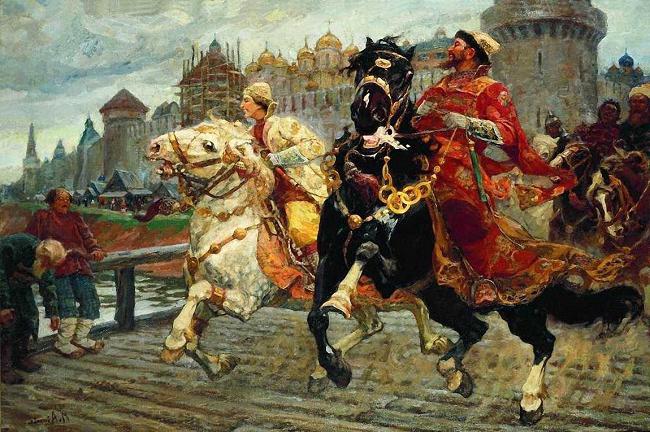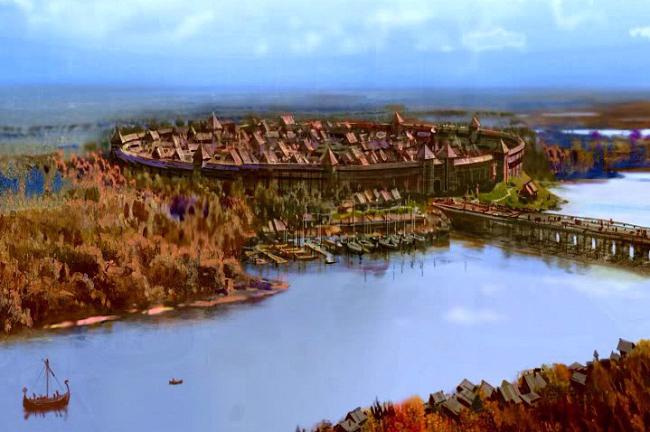In the middle of the XV century, the most important task that Ivan III had to cope with was the accession of Veliky Novgorod to Moscow. But he was not the only contender for these lands. The Grand Duchy of Lithuania tried to claim their rights to them.
Start of conflict
It is no secret that the history of Moscow has always been closely connected with Novgorod. The roots of the conflict go back to the feudal war that broke out among the descendants of Prince Dmitry Donskoy, which lasted several decades - from 1425 to 1453.
The main warring parties were Vasily Dark and Dmitry Shemyaka. After losing the battle for power, the latter took refuge in Novgorod. In 1449, Vasily Temny managed to conclude a favorable agreement with the Lithuanian prince and then Polish king Casimir IV that each of the parties would not accept each other's political opponents. In addition, Lithuania agreed to abandon the encroachment on Novgorod. After 4 years, Vasily with the help of his faithful people poisoned Shemyak.
Yazhelbitsky world
The history of Veliky Novgorod knows a lot of bloody battles. One of them happened in 1456 near a city called Rusa. Then the Moscow forces managed to take it quite easily and almost without resistance. But soon they were attacked by the Novgorod cavalry. Muscovites, led by their governor Strigi and Basenka, hid behind a snowy hill. They began to shoot arrows not at the Novgorod warriors, but at their horses. There was a mess. Novgorodians were wearing heavy armor, so they could not fight along with the Muscovites. As a result, most of the boyars were captured or killed.

Thus, Moscow won a complete victory over Novgorod. At the same time, the number of troops of the first side was 20 times less than the second. After some time in Yazhelbitsy, Vasily the Dark received the embassy, which was headed by the Novgorod Archbishop Euthymius II with the aim of concluding a peace treaty. After some negotiations, the parties signed a bilateral agreement. According to him, the losers had to pay the winner a sufficiently large indemnity, amounting to 8 thousand rubles. But the accession of Novgorod to Moscow did not take place. He remained independent for the time being.
The situation after the conclusion of peace
The history of Novgorod says that in 1136 it became the very first free republic located in the territory of Kievan Rus. It operated such a democratic institution as the veche. It lasted until the events that entailed the accession of Novgorod to Moscow. But, despite this, not all citizens supported the independence of their lands and were ready to fight for it.
It is worth noting the fact that the rights of ordinary, poor citizens were most often not respected, and the poorest people, which consisted of smerds, were generally deprived of the right to attend the veche. The gap between the poor and the rich was too wide, so ordinary Novgorodians were not eager to fight with Moscow for the rights of the boyars.
In 1460, Grand Duke Vasily Vasilievich arrived with the embassy in Novgorod for negotiations. But the townspeople opposed him and even tried to kill. So another conflict broke out, which was resolved by Bishop Jonah, who intimidated the Novgorodians with the invasion of the Tatars along with Muscovites.
3 years after the visit of Novgorod by the Moscow prince, this republic refused military support to Pskov, who asked him to help him fight off the attacks of the Livonian knights. Help came from Moscow. After that, Novgorod took an openly hostile position towards Pskov. This time the conflict was resolved by the wise policy of Prince Ivan III.
New odds
The Novgorod elite was constantly under constant pressure from two neighboring fairly powerful states - Moscow and the Principality of Lithuania. The boyars were well aware that they would be able to maintain their possessions only if an alliance was concluded with one of them.
The history of Moscow indicates the fact that disagreements over land annexation also existed in Veliky Novgorod itself. The boyars advocated an alliance with the Principality of Lithuania, because they hoped to preserve all their privileges, while ordinary citizens supported the tsar of Moscow, because in his person they saw, above all, the Orthodox ruler.
The reasons for the hostilities
The reason for the campaign in Veliky Novgorod in May 1471 was rumored to indicate that most of the boyars, led by Martha Boretskaya, the widow of the posadnik, signed an agreement with the Lithuanian side on vassal dependence. Many historians believe that these rumors were only a reason for reprisal. But still there is the fact that the Novgorodians asked to become their viceroy of the Lithuanian prince. In addition, they still sought to create their own church, independent of Moscow. That is why the campaign against Veliky Novgorod acquired the form of a war against apostates and for the restoration of the Orthodox faith.
The next campaign
This time hostilities against the republic were led by Moscow Prince Daniil Kholmsky. I must say that this was a considerable risk, since the spring that year turned out to be quite cold, and a large amount of snow that had not yet melted could significantly slow down the advance of the troops. But it was impossible to postpone the campaign. The Golden Horde and the Principality of Lithuania were ready to come to the aid of Novgorod.
In the early days of the campaign there were almost no fights. The Moscow army effortlessly captured the cities of the republic one after another. Only in the middle of July the Battle of Shelons took place. The army of Novgorod, consisting of 40 thousand people, and the 12 thousandth army of their enemy came together on the battlefield. The final outcome of this battle was decided by a powerful attack of the Moscow cavalry. Poorly organized Novgorodians could not resist such an onslaught.
2 weeks after the Battle of Shilon, another battle took place near the Shilenga River. It also ended in the victory of Muscovites. After that, negotiations began on the conclusion of peace in Korostyn.
Consequences of the Truce
As a result, Novgorod had to abandon the patronage of the Polish-Lithuanian king Casimir IV. In addition, the losers paid about 15 thousand rubles, and also actually recognized the supremacy of the Moscow prince. So the campaign of 1471 was more than successful. He proved that ordinary Novgorodians, unlike the boyars, do not want to fight with their neighbors.
In part, the fate of this republic was already a foregone conclusion. But the final accession of Novgorod to Moscow will take place only after 7 years.
Last trip
In the spring of 1477, not the first Novgorod embassy arrived in Moscow. But it turned out that it was sent not forever, but a bunch of boyars. They wanted the quickest and final recognition of the supremacy of Moscow, which would give them the right to preserve all their lands and wealth. This was learned in Novgorod. At the next veche several pro-Moscow boyars were killed, and supporters of the prince of Lithuania came to power. But their rule was short-lived.

In October 1477, the last campaign against the republic led by Ivan III took place. This time the Novgorod army did not go beyond the city. Long negotiations began. After 2 months, the Muscovites put forward the final requirements. They consisted in the abolition of the post and the cessation of the existence of the veche. The Novgorodians agreed with these two requirements, but the discussion about the preservation by the boyars of their estates was delayed. In the end, they still had to give the prince of Moscow monastery and lordly lands. This negotiation was over. On January 15, the Moscow prince and his associates, accompanied by squads, entered the city without a fight.
Summary
In history, 1478 is the year of accession of Novgorod to Moscow. The wars are finally over. This time there were no executions, but many boyar families were expelled from Novgorod. Among them was the posadnik Martha Boretskaya with her grandson. She was later tonsured a nun, and her possessions were confiscated.
When Novgorod joined Moscow, 4 governors, who had the right to dispose of the inheritance and conduct the courts, began to manage all the lands. Trade, agriculture and industry were now under the control of the new government.
The boyar leadership and veche were liquidated. The symbol of the independence of Veliky Novgorod - veche bell - was taken out. From that moment on, it became a secondary city, and Muscovy's possessions increased almost 2 times. Thus ended the history of Veliky Novgorod as a republic that has existed for more than three centuries.